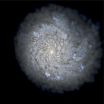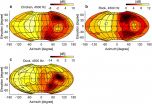(Press-News.org) San Antonio -- December 11, 2014 -- Southwest Research Institute (SwRI) is preparing to unveil a new, miniature portable solar observatory for use onboard a commercial, manned suborbital spacecraft. The SwRI Solar Instrument Pointing Platform (SSIPP) will be on exhibit at the fall meeting of the American Geophysical Union (AGU), Dec. 16-19, at the Moscone Center in San Francisco, Calif.
Using reusable suborbital commercial spacecraft for the SSIPP development effort improves on a traditional space instrument development process that goes back to the dawn of the space age, according to principal investigator Dr. Craig DeForest, a principal scientist in SwRI's Space Science and Engineering Division.
"Development and testing of space instrumentation has been essentially unchanged since World War II: New instruments were mated to sounding rockets, which are hand-built, miniature spacecraft that fly five-minute missions but require months, and sometimes years, between flights because the payloads typically need reconditioning after each flight.
"Commercial manned flights have the potential to completely change all that by providing a stabilized, completely reusable platform that is 30 times less expensive per flight than sounding rockets and can fly many times per week," DeForest said. "SSIPP is a first step to exploiting that platform. We hope to enable space-based observation in the same, inexpensive mode as ground-based observatories, where a scientist might build up a new instrument for a single observation and break it down a week later."
SSIPP uses a classic, two-stage pointing system similar to larger spacecraft, but in this case the first stage is a pilot who initially steers the instrument toward the Sun, explained Systems Engineer Jed Diller, also of SwRI. "SSIPP does the rest, locking onto the Sun to allow observations," he said.
The first SSIPP space flight will search for "solar ultrasound," which DeForest said is a phenomenon first observed in the early 2000s by the Transitional Region and Corona Explorer (TRACE) spacecraft. The "ultrasound" is sound waves with 10 second period, some 18 octaves deeper than ultrasound on Earth, and forms visible ripples in the Sun's surface layers. The waves are difficult to detect without space instrumentation, because the tiny, rapid fluctuations cannot be separated from the confounding influence of Earth's turbulent atmosphere, he said.
The first test flights of SSIPP will be aboard a general aviation aircraft during the spring of 2015. It is scheduled to fly on XCOR's Lynx suborbital spacecraft immediately on completion of XCOR's flight test program in 2015.
Although at first SSIPP will be operated from inside the cockpit, a full system eventually will be mounted outside the host vehicle to enable ultraviolet (UV) and X-ray observations that are inaccessible from the ground.
SSIPP will be on display at the XCOR booth, No. 2723.
INFORMATION:
DARIEN, IL - A new study shows that paid work time is the primary waking activity exchanged for sleep and suggests that chronic sleep loss potentially could be prevented by strategies that make work start times more flexible.
Results show that work is the dominant activity exchanged for less sleep across practically all sociodemographic categories. Compared to normal sleepers, short sleepers who reported sleeping 6 hours or less worked 1.55 more hours on weekdays and 1.86 more hours on weekends or holidays, and they started working earlier in the morning and stopped working ...
December 11, 2014 - Hospitals with robotic surgical systems are more likely to perform "nephron-sparing" partial nephrectomy--a recommended alternative to removal of the entire kidney--in patients with kidney cancer, reports a study in the December issue of Medical Care. The journal is published by Lippincott Williams & Wilkins, a part of Wolters Kluwer Health.
"Hospital acquisition of the surgical robot is associated with greater proportion of partial nephrectomy, an underutilized, guideline-encouraged procedure," write Dr Ganesh Sivarajan of New York University Langone ...
An interstellar mystery of why stars form has been solved thanks to the most realistic supercomputer simulations of galaxies yet made.
Theoretical astrophysicist Philip Hopkins of the California Institute of Technology (CalTech) led research that found that stellar activity -- like supernova explosions or even just starlight -- plays a big part in the formation of other stars and the growth of galaxies.
"Feedback from stars, the collective effects from supernovae, radiation, heating, pushing on gas, and stellar winds can regulate the growth of galaxies and explain why ...
Unlike mammals, birds have no external ears. The outer ears of mammals play an important function in that they help the animal identify sounds coming from different elevations. But birds are also able to perceive whether the source of a sound is above them, below them, or at the same level. Now a research team from Technische Universität München (TUM) has discovered how birds are able to localize these sounds, namely by utilizing their entire head. Their findings were published recently in the PLOS ONE journal.
It is springtime, and two blackbirds are having ...
NEW YORK, NY - Patients with operable kidney cancers were more likely to have a partial nephrectomy -- the recommended treatment for localized tumors -- when treated in hospitals that were early adopters of robotic surgery, according to a new study.
Researchers from NYU Langone Medical Center and elsewhere, publishing online December 11 in the journal Medical Care, report that by 2008, hospitals that had adopted robotic surgery at the start of the current century (between 2001 and 2004) performed partial nephrectomies in 38% of kidney cancer cases compared to late adopters ...
Novel research reveals that the risk of acute gout attacks is more than two times higher during the night or early morning hours than it is in the daytime. The study published in Arthritis & Rheumatology, a journal of the American College of Rheumatology (ACR), confirms that nocturnal attacks persist even among those who did not consume alcohol and had a low amount of purine intake during the 24 hours prior to the gout attack.
The body produces uric acid from the process of breaking down purines--natural substances in cells in the body and in most foods--with especially ...
Parkinson's disease sufferers have a different microbiota in their intestines than their healthy counterparts, according to a study conducted at the University of Helsinki and the Helsinki University Central Hospital (HUCH).
"Our most important observation was that patients with Parkinson's have much less bacteria from the Prevotellaceae family; unlike the control group, practically no one in the patient group had a large quantity of bacteria from this family," states DMSc Filip Scheperjans, neurologist at the HUCH Neurology Clinic.
The researchers have not yet ...
A team of researchers led by North Carolina State University has found that stacking materials that are only one atom thick can create semiconductor junctions that transfer charge efficiently, regardless of whether the crystalline structure of the materials is mismatched - lowering the manufacturing cost for a wide variety of semiconductor devices such as solar cells, lasers and LEDs.
"This work demonstrates that by stacking multiple two-dimensional (2-D) materials in random ways we can create semiconductor junctions that are as functional as those with perfect alignment" ...
Researchers have found new evidence that explains how some aspects of our personality may affect our health and wellbeing, supporting long-observed associations between aspects of human character, physical health and longevity.
A team of health psychologists at The University of Nottingham and the University of California in Los Angeles carried out a study to examine the relationship between certain personality traits and the expression of genes that can affect our health by controlling the activity of our immune systems.
The study did not find any results to support ...
Could there finally be tangible evidence for the existence of dark matter in the Universe? After sifting through reams of X-ray data, scientists in EPFL's Laboratory of Particle Physics and Cosmology (LPPC) and Leiden University believe they could have identified the signal of a particle of dark matter. This substance, which up to now has been purely hypothetical, is run by none of the standard models of physics other than through the gravitational force. Their research will be published next week in Physical Review Letters.
When physicists study the dynamics of galaxies ...

